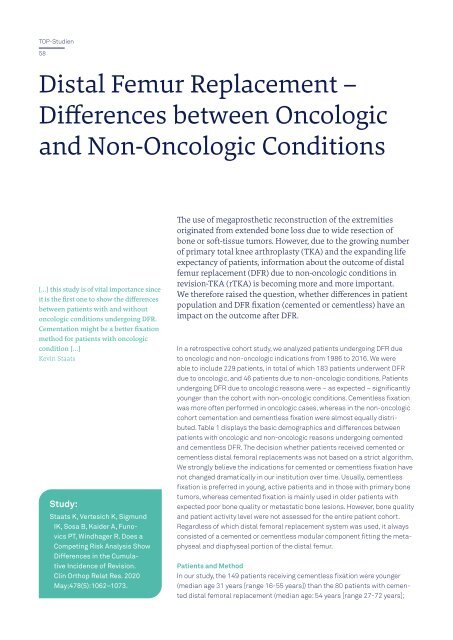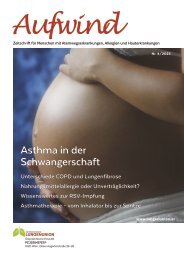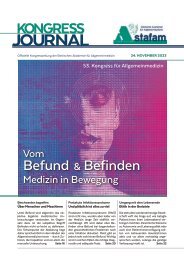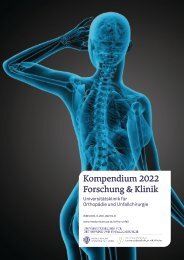Kompendium 2020 Forschung & Klinik
Das Kompendium 2020 der Universitätsklinik für Orthopädie und Unfallchirurgie von MedUni Wien und AKH Wien (o. Univ.-Prof. R. Windhager) stellt einen umfassenden Überblick über die medizinsichen Leistungen und auch die umfangreichen Forschungsfelder dar. Die Veröffentlichungen zeigen die klinische Relevanz und innovative Ansätze der einzelnen Forschungsrichtungen. Herausgeber: Universitätsklinik für Orthopädie und Unfallchirurgie MedUni Wien und AKH Wien Prof. Dr. R. Windhager ISBN 978-3-200-07715-7
Das Kompendium 2020 der Universitätsklinik für Orthopädie und Unfallchirurgie von MedUni Wien und AKH Wien (o. Univ.-Prof. R. Windhager) stellt einen umfassenden Überblick über die medizinsichen Leistungen und auch die umfangreichen Forschungsfelder dar. Die Veröffentlichungen zeigen die klinische Relevanz und innovative Ansätze der einzelnen Forschungsrichtungen.
Herausgeber: Universitätsklinik für Orthopädie und Unfallchirurgie
MedUni Wien und AKH Wien
Prof. Dr. R. Windhager
ISBN 978-3-200-07715-7
You also want an ePaper? Increase the reach of your titles
YUMPU automatically turns print PDFs into web optimized ePapers that Google loves.
TOP-Studien<br />
58<br />
Distal Femur Replacement –<br />
Differences between Oncologic<br />
and Non-Oncologic Conditions<br />
[…] this study is of vital importance since<br />
it is the first one to show the differences<br />
between patients with and without<br />
oncologic conditions undergoing DFR.<br />
Cementation might be a better fixation<br />
method for patients with oncologic<br />
condition […]<br />
Kevin Staats<br />
Study:<br />
Staats K, Vertesich K, Sigmund<br />
IK, Sosa B, Kaider A, Funovics<br />
PT, Windhager R. Does a<br />
Competing Risk Analysis Show<br />
Differences in the Cumulative<br />
Incidence of Revision.<br />
Clin Orthop Relat Res. <strong>2020</strong><br />
May;478(5):1062–1073.<br />
The use of megaprosthetic reconstruction of the extremities<br />
originated from extended bone loss due to wide resection of<br />
bone or soft-tissue tumors. However, due to the growing number<br />
of primary total knee arthroplasty (TKA) and the expanding life<br />
expectancy of patients, information about the outcome of distal<br />
femur replacement (DFR) due to non-oncologic conditions in<br />
revision-TKA (rTKA) is becoming more and more important.<br />
We therefore raised the question, whether differences in patient<br />
population and DFR fixation (cemented or cementless) have an<br />
impact on the outcome after DFR.<br />
In a retrospective cohort study, we analyzed patients undergoing DFR due<br />
to oncologic and non-oncologic indications from 1986 to 2016. We were<br />
able to include 229 patients, in total of which 183 patients underwent DFR<br />
due to oncologic, and 46 patients due to non-oncologic conditions. Patients<br />
undergoing DFR due to oncologic reasons were – as expected – significantly<br />
younger than the cohort with non-oncologic conditions. Cementless fixation<br />
was more often performed in oncologic cases, whereas in the non-oncologic<br />
cohort cementation and cementless fixation were almost equally distributed.<br />
Table 1 displays the basic demographics and differences between<br />
patients with oncologic and non-oncologic reasons undergoing cemented<br />
and cementless DFR. The decision whether patients received cemented or<br />
cementless distal femoral replacements was not based on a strict algorithm.<br />
We strongly believe the indications for cemented or cementless fixation have<br />
not changed dramatically in our institution over time. Usually, cementless<br />
fixation is preferred in young, active patients and in those with primary bone<br />
tumors, whereas cemented fixation is mainly used in older patients with<br />
expected poor bone quality or metastatic bone lesions. However, bone quality<br />
and patient activity level were not assessed for the entire patient cohort.<br />
Regardless of which distal femoral replacement system was used, it always<br />
consisted of a cemented or cementless modular component fitting the metaphyseal<br />
and diaphyseal portion of the distal femur.<br />
Patients and Method<br />
In our study, the 149 patients receiving cementless fixation were younger<br />
(median age 31 years [range 16-55 years]) than the 80 patients with cemented<br />
distal femoral replacement (median age: 54 years [range 27-72 years];
















